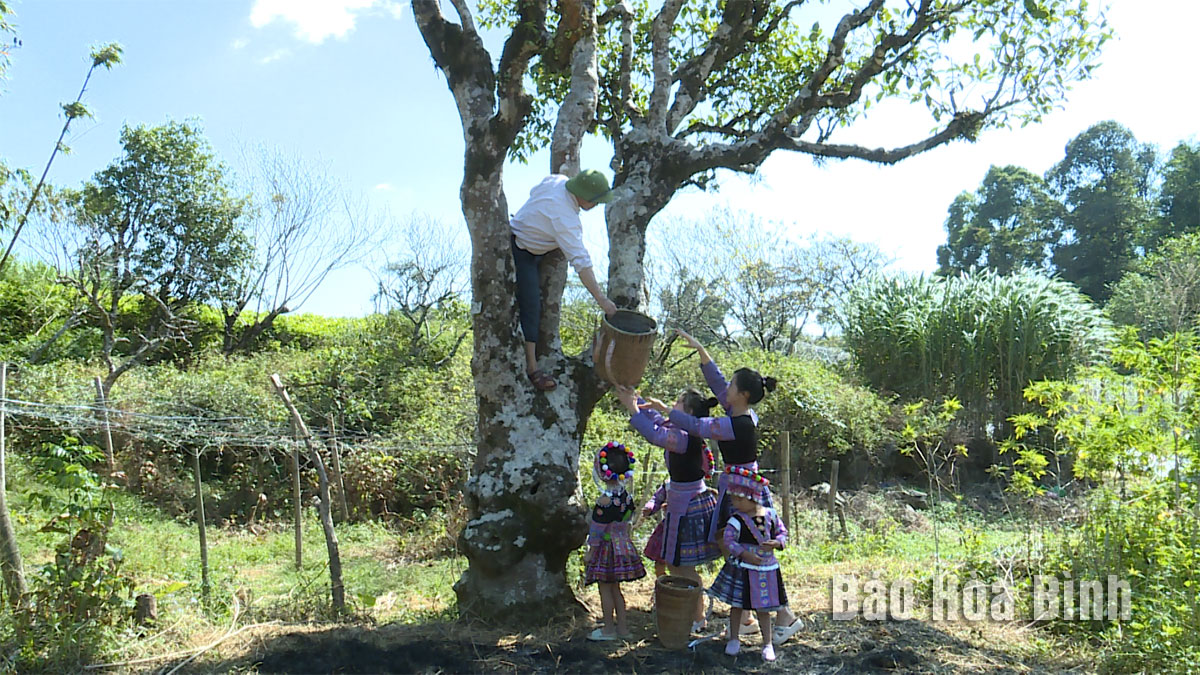


Farmers in Pa Co commune, Mai Chau district harvest tea on ancient Shan tuyet tea trees.
Currently, Pa Co commune in Mai Chau has over 80 hectares of tea under annual harvest. According to Vang A Cha, Vice Chairman of the Pa Co People's Committee, there are still some issues regarding the development of tea crops in the area, including the unauthorised sale of saplings taken from ancient tea trees to tourists, and improper pesticide use, which has led to the death of some ancient trees. Recently, the commune has increased efforts to educate local farmers and advised them not to sell any of the ancient tea trees to preserve the genetic resources and area. The commune also hopes that enterprises and experts will provide guidance on farming techniques and standards, ensuring the quality of tea throughout the production process and creating greater value upon harvest. Additionally, Pa Co hopes for further attention and direction from local authorities to gradually expand the tea-growing area and establish a brand for its tea.
Hoa Binh province currently has over 870 hectares of tea cultivation, with six districts hosting concentrated tea-growing areas thanks to advantages in soil, climate, historical heritage, and original tea varieties. These districts are Yen Thuy, Lac Thuy, Da Bac, Mai Chau, Tan Lac, and Luong Son. In early November, the agriculture sector began implementing the provincial People's Committee's plan to develop sustainable, multi-value tea cultivation in Hoa Binh from 2024 to 2030. The goal is to stabilise the total tea area at around 1,200 hectares by 2030, achieving a production volume of 13,800 tonnes, with 80% of the tea output meeting requirements regarding traceability, food safety, GAP (Good Agricultural Practices), and IPHM (Integrated Pest and Herbicide Management).
The processed tea products are expected to make up 20% of the total tea output, with 100% of the tea-growing areas being managed, assigned regional codes, and meeting import markets' requirements. The plan also targets five processed products, three intangible products, and a standard set for several Hoa Binh tea products.
The province also has plans for the scale of tea-growing areas and product diversification. For Shan tuyet tea, Mai Chau district is expected to have 200-250 hectares, while Da Bac will have around 100 hectares, and Tan Lac will cultivate 50 hectares. For green tea, the areas in Yen Thuy and Lac Thuy districts are expected to be between 400 and 500 hectares, while the urban area of Hoa Binh and Luong Son district will cultivate 250-300 hectares. In terms of processing and product diversification, localities will focus on setting up appropriate tea processing facilities for each raw material area, upgrading processing lines and technology, while preserving traditional hand-crafted tea workshops linked to local culture and specialties.
To this end, the local agriculture sector has outlined seven tasks and solutions, focusing on enhancing public awareness, changing agricultural production mindsets towards agribusiness, improving the organisation of production by businesses and cooperatives, and applying advanced technology to improve the quality and value of tea products. The plan also emphasises the restoration of indigenous tea varieties and the application of post-harvest, processing, and preservation technologies, with an emphasis on refining and deep-processing products. Furthermore, efforts will be made to promote trade, develop markets, build tea brands, and utilise e-commerce platforms. Investments will be made to enhance the capacity of businesses, cooperatives, and farmers, with stronger government management during plan implementation.
Bui Duy Linh, Deputy Director of the provincial Department of Agriculture and Rural Development, explained that developing concentrated tea-growing areas will improve the effectiveness of production, processing, and product sales through a value chain. The application of integrated scientific technology across all stages, from cultivation to processing, will enhance quality and diversify products, ensuring food safety and adhering to good agricultural practices. The plan will also focus on branding, product labelling, and increasing the competitive value of the tea products for sustainable development, said Linh.